Shopping for Cleaner, Greener Wheels
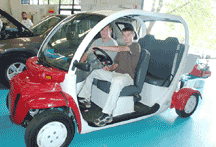 |
|
The Global Electric Motorcar looks like a red-and-white Beetle-sized golf cart, with open sides and a golf-cart trunk. It’s as slow as it
looks and can be legally driven no faster than 35 miles per hour.
|
I browsed alternative-fuel cars seeking my dream machine
by Carrie Madren
My guzzling Infiniti J30 burned a gallon and a half of gas getting me 36 miles to Catonsville, where I hoped to discover a cleaner, cheaper way to get around.
It was Alternative Fuels Day, and as I drove up Interstate 95 to one of the National Alternative Fuels Training Consortium’s Alternative Fuels showcases, at Baltimore County Community College, I daydreamed about pumping less gasoline into my car and less pollution into our air.
I’m just one 27-year-old person, but if I drove a fuel-efficient car for the rest of my life, I could prevent hundreds to thousands of pounds of air pollution, depending on which car choices I make in the next 73 years of my future. That’s assuming progeny lets me behind the wheel at 100 years old.
As well as clean and efficient, my car needs to be affordable. Just married, I’ve decided my priorities include fuel efficiency, longevity and reliability. I want a stylish car, nothing too weird or spaceship-like (think the old Honda Insight, with its back wheels only half exposed under the car body). Also, I want a sunroof.
I pulled up to the Showcase in the Automotive Technology Department’s warehouse, where students learn how to cure failing fuel injectors and maintain brakes. This day, their classroom had become a car showroom. Like opposing teams, two rows of nine alternatively fueled cars faced off: hybrids, electric cars, a flex-fuel car, a compressed natural gas car and a fuel-cell car.
Automotive students leaned into each car, checking out what was under these odd cars’ hoods. Young college students, high school kids and the car-curious ogled the machines, while experts leaned back, arms crossed, to explain the mechanics. I was one of two women adrift among men and their machines.
“I was thinking about getting a hybrid,” I said. “But I’m not really sure what kind of car I should be looking at.”
Terry Wolfe, the college’s automotive department coordinator, took me under his wing.
Hybrid Hype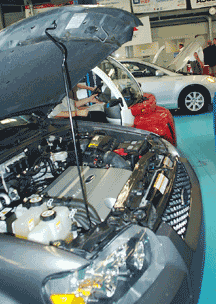
“Hybrids are for city driving,” said Wolfe.
I get stuck in my share of traffic, especially traversing Interstate 97 during rush hour.
I imagined myself crawling at a snail’s pace down West Street, watching my car’s monitor track electrical energy that I created while braking. The thought of using zero gasoline while my roadmates idled on petroleum made me giddy. Hybrids nowadays — since that Honda Insight — look similar to their gas-hungry cousins, but with a more modern edge.
A hybrid Ford Escape’s hood was popped open to show off its shiny interior. Priced between $27,000 and $32,000, the small SUV runs on battery power at speeds under 25 miles per hour, switching to its gas-powered engine over 25 miles per hour.
“I get about 30 miles per gallon on the highway,” said Mark Valesey, a Ford technical specialist who drove the Escape to the show that morning. “But in the city I get over 40 miles per gallon.”
The battery powering that driving lasts about eight to 10 years, or 100,000 to 150,000 miles, he said. Then, you’ll shell out over $7,000 to replace it. Some hybrids come with a 10-year warranty on the battery, which is located in the trunk. I found that out after naively gesturing to the car’s engine. I stand corrected.
Also, knowing just enough to put air in my tires and oil in my engine, I worry what would happen if something goes wrong in the intestinal system of the car, all those tubes, belts, gears and pistons. Can my trusted mechanic down the street fix it?
Yes. But conventional mechanics can’t work on parts of the car that are uniquely hybrid, like the braking system that helps charge the battery. For that, I’d have to go to a certified technician who’s gone through special training. I’d likely find one of them only at dealers selling the make of the hybrid I bought.
Besides the Escape, I also toured a white Prius and a 2007 Toyota Camry, whose doors unlock as you walk up to the car. (A special signal from a pocket or purse key keeps you from having to fumble around looking for a set of keys.)
The hybrid is the most visible alternatively fueled car on the road. I’d be among 14,216 other hybrid owners in Maryland.
Still, I do more highway driving, so I might do better than a hybrid. I also don’t like the idea of not being able to use my trusted mechanic who I’ve been going to for years. Finally, I intend to keep my car as long as I can, so I can’t justify buying a $7,000 battery for a car that might be worth the price of its battery in 10 years. I pressed on to see what other fuels might be for me.
Plug It In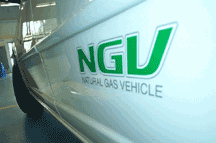
The electric car next in line looked like a red-and-white Beetle-sized golf cart, with open sides and a golf-cart trunk. It’s as slow as it looks. This Global Electric Motorcar and its electric cousins can be legally driven no faster than 35 miles per hour.
Such a car would be suited for trolling a bustling city.
“It’s not meant to be a highway car yet,” said Wolfe. But maybe someday we’ll get to zoom around in our electric cars and plug them in — much like we charge our cell phones — for three or four hours. Electrics use five 12-volt batteries, much like some boaters use to power their trolling or special outboard motor.
But the charge lasts only two and a half hours. What happens if I run out of charge on the road?
“You’d just have to look for a plug,” Wolfe said. That’s why the tiny cart-car comes with an extension cord in the trunk.
Electric carts are the first cousins of electric cars. Visiting the fuel expo is a two-person cart with a low, flat truck bed — almost like a mini pickup truck — bearing a 98 Rock sign.
“That’s one of the carts they drive around at the Ravens games,” Wolfe said. Some 35 of the Global Electric Motorcars, made in Fargo, North Dakota, now cruise Baltimore, each good for 35 to 40 miles on a charged battery.
Such tiny vehicles might soon find new jobs at marinas.
“A lot of people come in by boat, and there’s really no place to rent a car around marinas,” said Daniel MacDonald, vice president of NevAds, operating in Baltimore, which owns the low-speeds-only vehicles.
“We’re looking into putting GPS units in them so people can take self-guided tours around the city,” MacDonald said.
An interesting concept, but I need a vehicle I can take to the open road at speeds over 35 miles per hour. Plus, I might trip over the power cord running from my parking spot to my townhouse. I pressed on.
Going Natural
Next stop was a white Honda Civic that runs on compressed natural gas. Michael Li of the Maryland Energy Administration drives it to work and for work as part of the state fleet.
Because the natural gas tank fits behind the back seat, the trunk can’t hold much more than a bag of golf clubs.
An even tighter squeeze is the shortage of fuel: Maryland has only eight public natural gas fueling stations.
In California, however, drivers of natural gas cars are helping pilot a new system that diverts natural gas — coming into the home for heating and cooking — to refuel cars. Imagine, a gas station in your own garage.
“It’s about the size of your breaker box,” said Li. The 2005 Federal Energy Bill offers a $1,000 tax credit to buyers of these new refueling boxes.
We don’t have home pumping stations in Maryland because we don’t yet have a way to charge tax for the natural gas pumped. Marylanders can expect to have that option in about a year, Li said.
Natural gas cars do put out some emissions, though much less than a normal gas-guzzler.
“I think some of the Toyota hybrids are slightly cleaner,” Li said.
If you’re willing to go the extra miles for natural gas, or live near one of the fueling stations, this alternative fuel vehicle is one of the more affordable options. Many are under $20,000, about $2,000 more than a regular Honda Civic.
Though natural-gas-fueled cars come in the same common models and makes of normal gas-powered cars, I don’t think they’re the perfect car for me. I don’t live near a natural gas station — nor would I want to make 30-minute trips just to get gas — and I don’t use natural gas at home. I hadn’t found the right car yet.
Technology for Another Year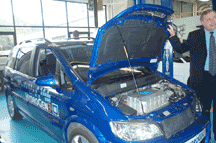
Four tall men surrounded the blue hydrogen-fueled van. “How about that one,” I asked, knowing hydrogen-fueled vehicles weren’t plentiful on the road. “What’s the price difference for those?”
Wolfe smirked. “It’s about a million and a half dollars right now,” he said. But it’s like any new technology, he explained. Price declines as an invention becomes more available and popular. Decades ago, computers cost $6,000 or $7,000. Now you can pay as little as $500.
That price should come down by 2015, when General Motors, the maker of the fuel-cell cars, persuades its partner, Shell, to build more hydrogen fueling stations, explained Matt Atwell, a General Motors engineer. Today, the only place to refuel with hydrogen is a Shell station off Benning Road in Washington, D.C.
Such fuel cell cars — called HydroGen3 — can take either compressed hydrogen (the easier-to-store form of hydrogen, which consumers will use in 2015) or liquid hydrogen. Liquid hydrogen can fuel cars more efficiently, but is more costly and troublesome, as it has to be stored at minus 423 degrees Fahrenheit.
Compressed hydrogen users shouldn’t feel slighted. The fuel still produces some 95 kilowatts instantly, Atwell said. For perspective, one kilowatt is enough for one U.S. home to keep the lights on, run the refrigerator, the air conditioner and everything else for a second.
Besides using a renewable resource, this car gets green points for tailpipe emissions. These hydrogen-powered, fuel cell cars emit only water.
The U.S. Postal Service leases and tests one of GM’s HydroGen3 fuel-cell cars on routine routes three times a week, bringing D.C. residents their mail.
So why is there a public station in D.C., I asked, if there are only a handful of cars that can actually use the fuel?
“To let people know that these cars are out there,” Atwell said. “They’re not just some futuristic dream.”
They’re still a futuristic dream for me, and way out of my price range.
Staying Flexible
I moved down toward the last car, a black mid-sized, four-door Chevy flex-fuel vehicle, according to a yellow-and-green-lettered banner splayed across both sides of the car.
If you’re a highway driver, explained Wolfe, your best bet is a flex-fuel vehicle that can run on E85 (a blend of 85 percent ethanol), regular gasoline or any blend in between. So the engine can run most efficiently, it uses light refraction to detect the ethanol content of the fuel you’ve pumped.
Ethanol can be made from corn or cornstalks, barley, wheat, rice straw, pulpwood, switchgrass, sugar cane or municipal solid waste.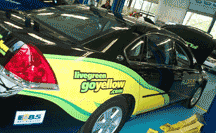
“A lot of people have these cars but don’t know that their car can run on E85,” says Lauren Robbins, spokeswoman for the Maryland Energy Administration.
To get the word out, she and her staff sent out coupon mailers to people within a five-mile radius of Maryland’s ethanol stations. Not until regular gasoline prices skyrocketed after Hurricane Katrina did many take up the offer. The administration has also set up tables at concerts and collaborates with WRNR on a special day at the Annapolis Citgo, where ethanol users only paid $1.03 — the radio station’s call number — for their fuel.
Maryland citizens can fuel up on E85 in three locations; one is the Citgo in Annapolis, near Route 450 at Riva Road. A dozen other ethanol stations in the state only pump out to private or government fleets. Pumping E85 brings an immediate reward to station owners: under the Energy Policy Act of 2005, fueling stations get a 30 percent tax break on the cost of installing an ethanol pumping station. To get more Maryland stations to carry bio-fuels (a category that encompasses both ethanol fuels and bio-diesels), Maryland government kicked off a $100,000 grant program on November 1. Retailers can apply this fall for grants to help pay for bio-fuel tanks, pipes and other inner workings that a fueling station needs.
Stations can apply for grants to cover 50 percent of their project, or up to $12,500. If a station puts in two kinds of bio-fuels, the grant rises to $30,000. Awards will be made January 15, and stations must have their projects completed by June 30, 2007.
So we may be seeing more E85 fueling stations soon.
Besides replacing oil, a non-renewable resource, ethanol reduces carbon dioxide emissions relative to gas. Also, the U.S. imports oil, but ethanol is domestically produced, so it’s good for farmers and keeps money in the U.S. economy.
To buy a flex-fuel car, you’d probably spend some $4,000 less than on one of the more expensive hybrids.
Some 70,331 flex-fuel vehicles roam Maryland byways. Most flex-fuel cars are modified standard models — including Chevrolet Impala, Monte Carlo, Ford Taurus, Ford Crown Victoria, Mercury Grand Marquis and Lincoln Town Car — so they look just like normal gas-gulpers.
“The Crown Victoria I drive is a flex-fuel,” Wolfe said. “There’s a lot of cars that are flex-fuel, but other drivers can’t tell.”
If I bought a flex-fuel car, I’d have a wide range of models and makes to choose from. Plus, I’d get the benefit of driving on a renewable American resource. But to get the full advantage of not polluting, I’d be at the mercy of three gas stations — all at least 30 minutes from my house.
Lessons Learned
The next big alternative-fuel vehicle might be like the BETA-VHS debate of the 1980s. But if you don’t mind being a small fish in a big pond, there are options. If you want to run with the clean fuel crowd, however, the hybrid or a flex-fuel car is your best bet.
Through my search at the Odyssey Day, I learned that there’s no perfect match for me. Each of the choices was flawed. The closest match I had with these cars seemed to be a flex-fuel vehicle with high gas mileage. But with only three ethanol-pumping gas stations in the state, I’m not lured to pay the price difference. So I’m still searching for the perfect car — and waiting on technology.
For more information about alternatively fueled cars, including how to locate fueling stations, visit www.eere.energy.gov.







